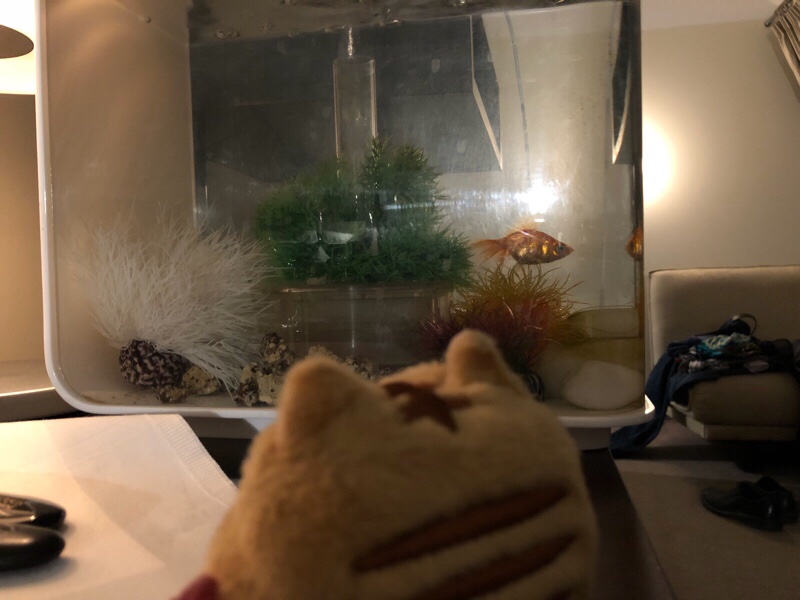
(Above: Catbun enjoying a last look at the goldfish in our room.)
We had one more sight to see today before leaving Prague, since our train wasn’t until the early afternoon: the Museum of Medieval Art, conveniently housed in the convent of the Sisters of St. Agnes, just a short walk from our hotel.

I’ll be a little sad to say goodbye to the Maximilian; we had a lovely stay there even accounting for the mysterious lack of top sheets and indifferent-if-extant air conditioning that haunts Europe generally. Happily, there was safe storage for our luggage, so after our checkout we made our way through the streets one last time and entered the little cloister.
This is still a working convent, I believe, though I did not see anyone wearing religious garb – and what remains of the old convent’s interior is just that – an interior, with very little in the way of furnishings or signifiers to indicate that one room was once much different from another. But the main reason one is there is, of course, the art, so let’s get to that.
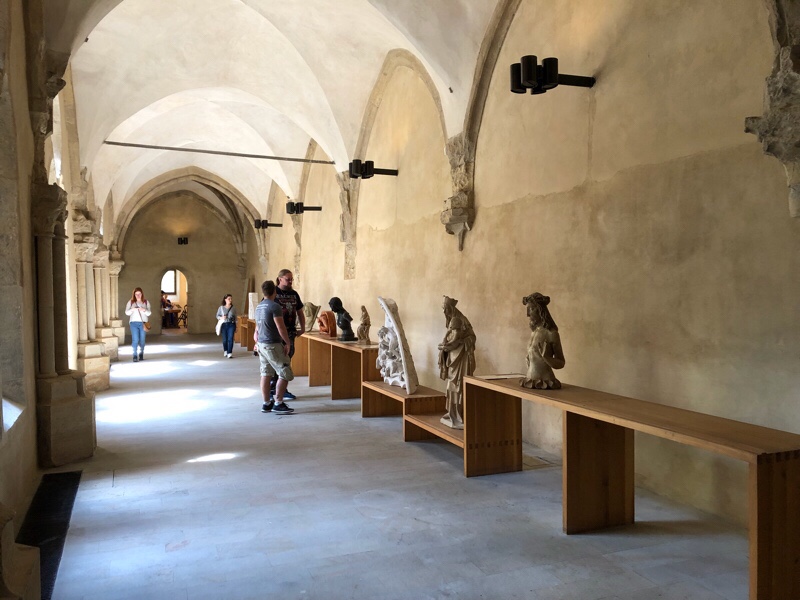
It’s medieval art, and from that we can assume a number of common traits: religious subject matter, frequently anonymous artists, a wide and varied range of degrees of mastery when it comes to things like perspective and naturalism.
Oh, and photobombs. Usually by angels. You would seriously be surprised juuuuust how often in medieval art an angel is like “oh hey, guys!” and pops into the picture at a random angle that doesn’t seem to have anything to do with much of what’s going on in the pictures.
Some of the art is legitimately beautiful and contemplative; it’s easy to imagine how in the gray-brown world of the medieval peasant the church may well have been the only place where one was able to see beautiful things. One of the only places, perhaps I should say. There were always the flowers of the field, and the sky after a rain, and the like. But there was a time when almost all of what we think of as visual art was to the greater glory of god, and this collection of it is rather fine.
Some of it I recognized – some Dürer woodcuts, rather flagrant in their apocalyptic-ness. Much of it I did not: altarpieces that folded up, cleverly arranged so as to show an arrangement of saints no matter how they were folded; a wide variety of carved wooden crucifixes and pietas and painted lamentations. Over and over again Mary Magdalene washes Jesus’s feet with her hair; over and over again Christ goes to the Mount of Olives, over and over again, disciples gather at his feet, or in darkened rooms too like a tavern in Bohemia to be strictly accurate.
Some of them are lovely, if somber, scenes. Some of them, to a modern eye, read a bit differently than the artist (probably) originally intended. Matthew looks serious, Mark looks as if he is thinking about lunch, Luke has the wary hesitant half smile of someone not sure if the camera is pointing at him, and John seems entirely Over It, thank you. Gathered at the crucifixion, invention seems to have run out when it came to coming up with different expressions of agony or grief for the disciples to display: here profound sorrow, there a grimace of pain, here something more evocative of digestive distress than emotional angst. A Roman soldier in the wrong armour for his place and time flashes the viewer some distinctive side-eye, as if to say “Can you believe this shit?”
I feel a little disrespectful, admittedly, stating these observations out loud…but honestly, that really IS how it looked. Still, it’s a lovely collection, and aside from the inevitable squad of schoolchildren, a pleasantly un-crowded one for our final Prague sight.
Outside is a little sculpture-garden, including this charming little playhouse that is apparently actually one of the sculptures.

I wonder if anyone is allowed to play on it? The school group was nowhere to be seen at the time, so there was nobody around to test the theory.
By now it was getting on to that time, so we headed back to the Maximilian, where we reclaimed our bags and hopped into a cab headed for the main station. Here we thanked our past selves for that run out to Kutna Hora a couple of days ago: nothing like a little practice with the trains to make finding your platform, etc, a little easier. A short wait later and we climbed aboard a train headed for “Wien Hbf,” aka Vienna (the “Hbf” is the typical abbreviation for “Hauptbahnhof” or main train station.)
We had first-class tickets for this trip – an odd quirk of the Prague-Vienna trains is that you can purchase tickets for them through either the OBB (the Austrian transit authority that actually runs the train as far as I can tell) or CD (the Czech rail system, pronounced something like “Chesky drah-hee”)…and the Czech price can sometimes be cheaper for precisely the same seat. As we also bought well in advance, this meant we could easily swing a spot with a bit more leg room for our 4-hour trek.
One thing I remember from my last trains-in-Europe experience is that for some reason one always expects that the borders will feel more distinct than they are – as if somehow crossing from Italy to Germany will result in the grass being a different green or something, which of course is nonsense. In this case, pretty pastoral countryside continued on both sides of the border, broken up occasionally by assorted small towns and the like. The only really notable differences? Signs swap primary languages from Czech to German (meaning I was no longer QUITE functionally illiterate, hooray) and at the last Czech stop we were slightly astonished to see just about everyone else in the car pile out of the train, which lingered a bit longer than normal. Perhaps the staff have to swap when the border changes?
In any case, it was a very comfortable journey, even with minor hiccups like an in-seat food ordering system that didn’t quite “take” when we put our order in for some sandwiches.
Another thing I remember is how striking the differences between train stations could be, and the transition from Prague’s to Vienna’s was marked by a sudden spike in signage, as well as in available staff who could point you toward whatever it was you were looking for – in our case the 13A bus toward Siebensterngasse, which wound through the streets of the city to an area that gradually began to resemble Queen West.
Vienna was described to me as being “basically Toronto” before this trip, though I’m not entirely sure I agree. For one, there is a notable lack of either the kind of glass and steel condo developments that all of residential downtown seems to be gradually turning into or the skyscrapers that make up most of the “business” downtown. Instead, you have relatively tidy blocks of three-to-five story buildings, many of which seem to subscribe to some sort of unspoken (or perhaps it’s quite spoken, and I just don’t know that) European building code: windows shaped just so, and double-glazed after a fashion, with a casement that opens inward and another that opens outward. Facades to be white, or at least aiming for white; signage neat and prominently displayed in blue and white.
Oh, and for a second difference: unlike Toronto’s, the public transit in Vienna actually works. It’s brisk and efficient, just make very sure you have validated your ticket or else you may be liable for a stiff fine.
We hopped off at Siebensterngasse and looked round for our next lodgings, eventually locating the green “Hotel Kugel” sign near the corner. This is a hotel dating back to the 1800s, and a certain retro quality was present throughout its fittings (thankfully, there’s a modern if tiny elevator.) Our room was every bit as frilly as one could possibly hope for in Vienna:

Alas, still no top sheet, but a very welcome fan. A nice view, too:
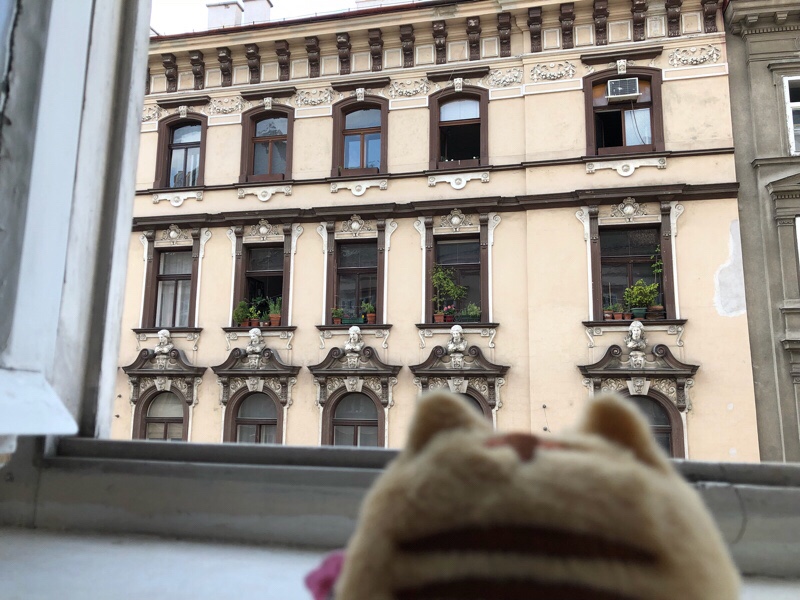
Once our bags were dropped off safely, we pondered our next course of action, eventually settling on “let’s go get oriented with our first evening, the way we did in Prague.” We’ve been following the Rick Steves guide for this trip, and a ride around the Ringstrasse tram with an audio tour we downloaded seemed like just the thing.
With a little help from Google Maps we worked out the right general direction and set off. Things you notice almost immediately:

- Traffic lights are back. I don’t think we saw one of these in Prague anywhere; as Jan noted on our food tour, whatever is coming from the right has right of way, and since everyone knows this, voila, no fuss. (Though I admit to having found it disconcerting.)
- A number of the traffic lights for pedestrians in Vienna represent same-sex couples, waiting patiently (or perhaps snuggling) side by side when the light is red and strolling gaily across when it’s green, with a little heart between them. They’re extremely cute.
- The streets here seem to have far fewer windings and tangles than in Prague. One gets the sense that more of the growth here was planned rather than organic – and perhaps it was; one doesn’t have to be more than an indifferent student of history to recognize that Vienna was an imperial capital for a very, very long time.
A few blocks away from the Siebensterngasse stop, the street bumped into a little flight of stairs. Curious to see whether these would allow us to cut straight through a block, as the little arched tunnels in Prague often do, we tried them – and found ourselves going down a much, much longer flight of stairs into something labeling itself prominently “Museumsquartier.” (At a guess, this is because, well, there were some museums and galleries here judging by the signs; notably modern art if these were anything to go by.)

The sort of square at the base of the stairs was clearly setting up for some sort of concert, but almost all of the space not populated by workers and steel constructs was taken up by abstract couches in bright purple, populated by the sort of fashionable young people who make me feel rather drab at the best of times, all eager German conversation.
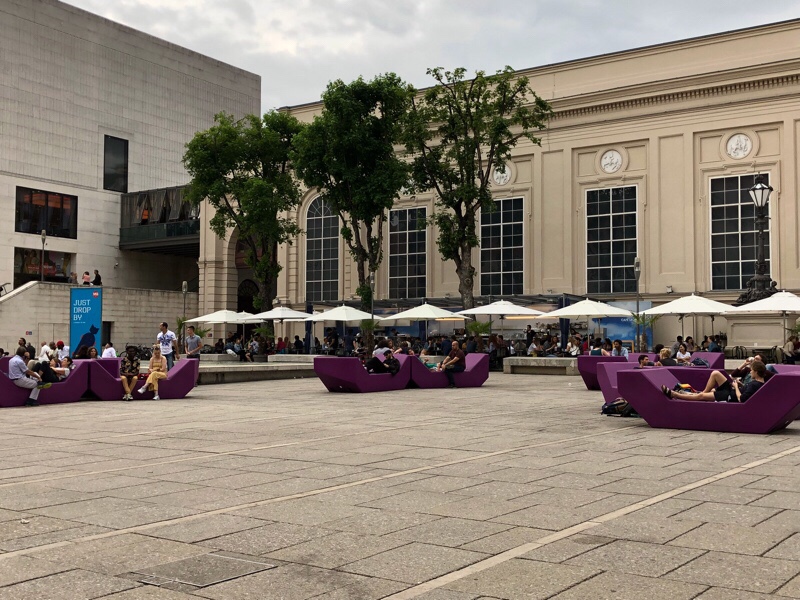
Beyond this, we emerged onto a street fronted by a grand-looking park dominated by a large sculpture of a woman enthroned who reminded me a little of statuary of Victoria, flanked by some fairly spectacular buildings; as a sign nearby read “M. Theresien-platz” I assumed this must be Maria Theresa. (Future Me: I was right, as the next morning would confirm.)
Past this and round a corner we made it at last to the Ringstrasse – the innermost of Vienna’s ring roads that encircles its densest concentration of sights. Here we had a bit of a disappointment: the tram stops here for several blocks had a sort of blue metal cross-like thing mounted over each of them. “Verlassen,” it said. Lost? No. What the hell was that word? I eventually resorted to Google Translate and had an unpleasant surprise: “Abandoned.”
It seems that a chunk of the ring tram is out of commission at the moment. Lovely. Well, so much for THAT plan. Instead we made for the nearest likely source of dinner – a sort of pub-like restaurant with a propensity for collecting beer themed kitsch in a variety of languages. Well. It’d do; we settled in for a reasonably tasty schnitzel and some kind of meat-filled dumplings with sauerkraut and planned our next move.
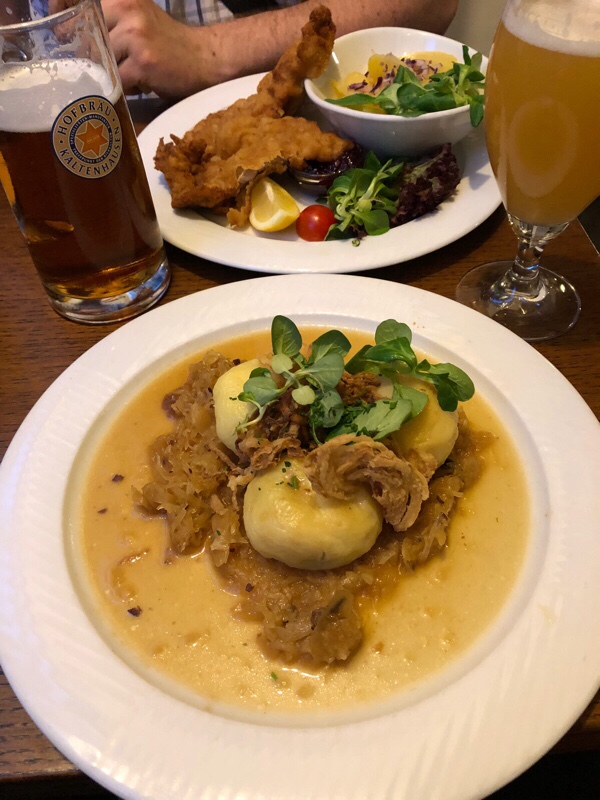
This was, as it was getting late, simply to do a stroll around the Opera area, taking in the sights. Vienna in the evening was sedate, but in a charming sort of way and around behind the Opera house was one of those things that’s on the Vienna bingo card:

That’s Cafe Sacher, home of the Sachertorte – a dense chocolate cake with a fruity center layer and a ganache-like icing. You may have heard of it? Anyway, why the hell not – we headed in and placed an order for two of them, with a coffee each.
Or a “melange,” rather – something like a cappuccino. Coffee isn’t served here with milk separately as it is in North America; if you want milk in your coffee it’s best to order it in a preparation that includes some.
The tortes were brought to the table by a waitress in an honest to goodness maid outfit, and came with a little seal of officialness, also in chocolate:

Drier than I was expecting, but tasty all the same.
On that note we headed off to bed. Another long day tomorrow.
Have a nighttime view of Vienna or two while you wait for the next post:

